Bunk Beds for Kids: A Comprehensive Guide
Bunk beds have been a popular option for children's bedrooms for many years. They provide a space-saving solution that takes full advantage of floor location, provides enjoyable climbing up choices, and comes in a range of styles that appeal to children's creativities. This post explores the advantages, considerations, designs, and security functions connected with bunk beds for children.
Advantages of Bunk Beds
Bunk beds present numerous advantages that make them an appealing choice for families. Here are some crucial benefits:
Space Saving
- Bunk beds enable 2 or more kids to share a room without compromising space for play or other activities.
Economical
- Acquiring a single bunk bed can be more affordable than purchasing 2 separate beds.
Enjoyable Factor
- Kids frequently see bunk beds as an enjoyable location to sleep and play, cultivating a sense of experience.
Adaptability
- Bunk beds are available in different configurations, including L-shaped, loft beds, and even convertible designs that can alter as children grow.
Organization
- Numerous bunk beds come with built-in storage choices, such as shelves and drawers, helping keep spaces arranged.
Secret Considerations Before Purchasing
Before purchasing a bunk bed, it's important to think about particular elements, such as:
- Space Requirements
Procedure the space to ensure that there is sufficient vertical space, permitting appropriate headroom on the top bunk. - Age of Your Children
Consider their age and maturity. Lots of manufacturers recommend that kids under six need to not oversleep the leading bunk due to security concerns. - Weight Limit
It's vital to inspect the weight limits of the bunk bed for both the top and bottom bunks to make sure safety. - Style Preferences
Pick a design that matches the space's design and the children's choices. - Product
Bunk beds are available in different products, such as wood or metal. Each has its advantages and downsides regarding toughness and looks.
Styles of Bunk Beds
Bunk beds can be found in numerous styles to fit different visual appeals and functional requirements. Here's a list of some popular designs:
- Standard Bunk Beds
Traditional stacked beds that include two beds developed one above the other. - Loft Beds
A bed elevated high off the ground, with space underneath for a desk, play area, or storage. - L-Shaped Bunk Beds
2 beds set up in an L-shape, providing more flooring space and an unique design element. - Twin Over Full Bunk Beds
These choices include a twin bed on the top and a full-sized bed on the bottom, accommodating older children or adults. - Triple Bunk Beds
Designed for three children, these beds normally consist of three stacked beds, perfect for bigger households.
Security Features to Consider
Guaranteeing the security of kids using bunk beds is vital. Here are some security features to try to find before making a purchase:
- Guardrails
A bunk bed must include strong guardrails on the top bunk to avoid accidental falls. - Ladders
Ensure that the ladder is securely attached and easy for kids to browse safely. - Stability
Look for bunk beds with lower centers of gravity and wide bases to supply better stability. - Quality Construction
Pick beds made from resilient products that satisfy safety requirements, such as ASTM (American Society for Testing and Materials) regulations.
FAQs About Bunk Beds
1. What age is suitable for a leading bunk?Generally, children aged six and older are suggested for oversleeping the leading bunk. 2. Are bunk beds safe for toddlers?Most specialists recommend against
positioning young children in the leading bunk due to the
danger of falls and inappropriate ladder use. 3. Can bunk beds be separated?Many bunk beds are designed to be separated into two standalone beds,
offering included flexibility as kids grow
. 4. How do I keep a bunk bed?Regularly check for loose screws and wear, keep bed mattress tidy, and guarantee that the bunk bed is
steady to lengthen its life-span. 5.
Are there any special mattress requirements for bunk beds?Yes, Read A lot more for bunk beds must fit snugly without leaving spaces. Generally, thinner bed mattress
(around 6 to 8 inches )are recommended for leading bunks for safety. Bunk beds offer a flexible, practical, and enjoyable option for children's sleeping arrangements, maximizing space while accommodating several kids in one space. By thinking about the crucial factors
of style, safety, and space, parents can make an informed choice when choosing the right bunk bed for their children's needs. With the best care and upkeep, a bunk bed can be a precious piece of furnishings that provides years of usage and pleasure for kids. Summary Table of Bunk Bed Styles Style Description Best For Standard Bunk Beds Traditional style, two stacked beds Smaller sized spaces Loft Beds Elevated bed with open space beneath Study or play locations L-Shaped Bunk Beds Two beds in an L-shape
Added flooring space Twin Over Full Twin on the top,
| full on bottom Accommodating older children Triple | ||||||
|---|---|---|---|---|---|---|
| Bunk Beds | 3 stacked beds | Bigger families By understanding | the various options readily available, designated factors to consider for safety and performance, and proper age guidelines, households | can choose the ideal bunk bed that not | only enhances their living space | however likewise ensures a safe and |
| satisfying sleeping environment | for their kids.

|
